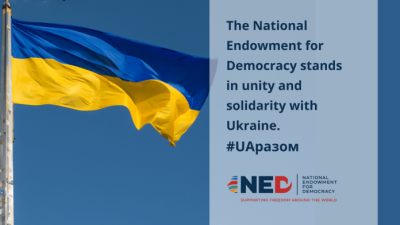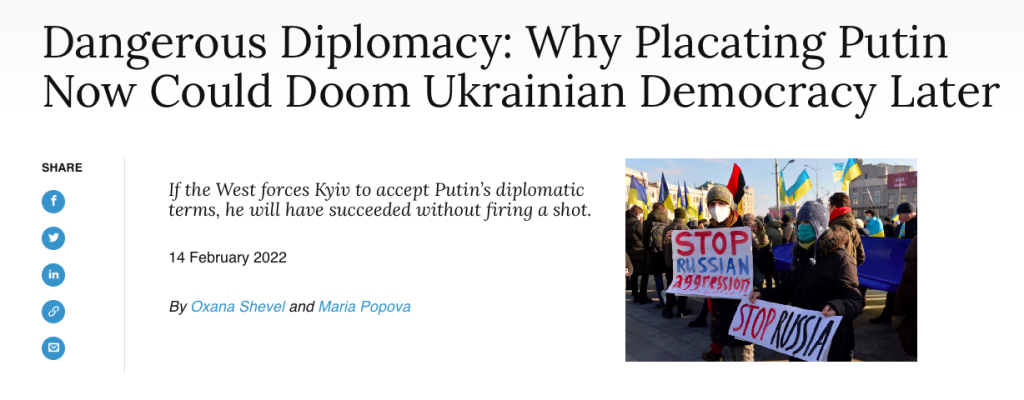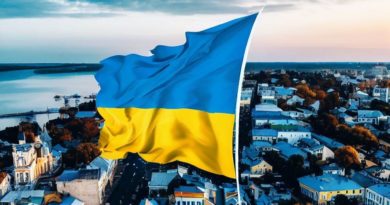Anatomy of a Coup: How CIA Front Laid Foundations for Ukraine War

To receive Global Research’s Daily Newsletter (selected articles), click here.
Follow us on Instagram, Twitter and Facebook and subscribe to our Telegram Channel. Feel free to repost and share widely Global Research articles.
***
Obvious examples of Central Intelligence Agency covert action abroad are difficult to identify today, save for occasional acknowledged calamities, such as the long-running $1 billion effort to overthrow the government of Syria, via funding, training and arming barbarous jihadist groups.
In part, this stems from many of the CIA’s traditional responsibilities and activities being farmed out to “overt” organizations, most significantly the National Endowment for Democracy (NED).
Founded in November 1983, then-CIA director William Casey was at the heart of NED’s creation. He sought to construct a public mechanism to support opposition groups, activist movements and media outlets overseas that would engage in propaganda and political activism to disrupt, destabilize, and ultimately displace ‘enemy’ regimes. Subterfuge with a human face, to coin a phrase.
Underlining the Endowment’s insidious true nature, in a 1991 Washington Post article boasting of its prowess in overthrowing Communism in Eastern Europe, senior NED official Allen Weinstein acknowledged, “a lot of what we do today was done covertly 25 years ago by the CIA.”
It Begins
Fast forward to September 2013, and Carl Gershman, NED chief from its launch until summer 2021, authored an op-ed for The Washington Post, outlining how his organization was hard at work wresting countries in Russia’s near abroad – the constellation of former Soviet republics and Warsaw Pact states – away from Moscow’s orbit.
Along the way, he described Ukraine as “the biggest prize” in the region, suggesting Kiev joining Europe would “accelerate the demise” of Russian President Vladimir Putin. Six months later, Ukraine’s elected president Viktor Yanukovych was ousted in a violent coup.
Writing in Consortium News earlier that month, investigative legend Robert Parry recorded how, over the previous year, NED had funded 65 projects in Ukraine totaling over $20 million. This amounted to what the late journalist dubbed “a shadow political structure of media and activist groups that could be deployed to stir up unrest when the Ukrainian government didn’t act as desired.”
NED’s pivotal role in unseating Yanukovych can be considered beyond dispute, an unambiguous matter of record – yet not only is this never acknowledged in the mainstream press, but Western journalists aggressively rubbish the idea, viciously attacking those few who dare challenge the established orthodoxy of US innocence.
As if to assist in this deceit, NED has removed many entries from its website in the years since the coup, which amply underline its role in Yanukovych’s overthrow.
For example, on February 3rd 2014, less than three weeks before police withdrew from Kiev, effectively handing the city to armed protesters and prompting Yanukovych to flee the country, NED convened an event, Ukraine’s lessons learned: from the Orange Revolution to the Euromaidan.
[embedded content]
It was led by Ukrainian journalist Sergii Leshchenko, who at the time was finishing up an NED-sponsored Reagan–Fascell Democracy Fellowship in Washington DC.
Alongside him was Nadia Diuk, NED’s then-senior adviser for Europe and Eurasia, and graduate of St. Antony’s College Oxford, a renowned recruiting pool for British intelligence founded by former spies. Just before her death in January 2019, she was bestowed the Order of Princess Olga, one of Kiev’s highest honors, a particularly palpable example of the intimate, enduring ties between NED and the Ukrainian government.
While the event’s online listing remains extant today, linked supporting documents – including Powerpoint slides that accompanied Leshchenko’s talk, and a summary of “event highlights” – have been deleted.
What prompted the purge isn’t clear, although it could well be significant that Leshchenko’s talk offered a clear blueprint for guaranteeing the failure of 2004’s Orange Revolution – another NED-orchestrated putsch – wasn’t repeated, and the country remained captured by Western financial, political and ideological interests post-Maidan. It was a roadmap NED subsequently followed to the letter.
Along the way, Leshchenko specifically highlighted the importance of funding NGOs, exploiting the internet and social media as “alternative [sources] of information,” and the danger of “unreformed state television.”
So it was that on March 19th, representatives of the far-right Svoboda party – which has been linked to a false flag massacre of protesters on February 20th, an event that made the downfall of Yanukovych’s government a fait accompli – broke into the office of Oleksandr Panteleymonov, chief of Ukraine’s state broadcaster, and beat him over the head until he signed a resignation letter.
That shocking incident, motivated by the station broadcasting a Kremlin ceremony at which Vladimir Putin signed a bill formalizing Crimea as part of Russia, was one of many livestreamed by protesters that traveled far and wide online.
The brutal defenestration of Ukraine’s state TV chief notwithstanding, much of this livestreamed output served to present foreign audiences with a highly romantic narrative on the demonstrations, and their participants, which bore little or no relation to reality.
The Revolution Will Be Televised
Writing in NED’s quarterly academic publication Journal of Democracy in July that year, Leshchenko discussed in detail the media’s role in the Maidan coup’s success, drawing particular attention to the fundamental role of “online journalist” Mustafa Nayyem.
He kickstarted the protests the previous November, rallying hundreds of his Facebook followers to protest in Kiev’s Independence – now Maidan – Square, after Yanukovych scrapped the Ukrainian-European Association Agreement in favor of a more agreeable deal with Moscow.
Nayyem was no ordinary “online journalist”. In October 2012, he was one of six Ukrainians whisked to Washington DC by Meridian International, a State Department-connected organization that identifies and grooms future overseas leaders, to “observe and experience” that year’s Presidential election.
Funded by the US embassy in Kiev, over 10 days they “[gained] a deeper understanding of the American electoral process,” meeting candidates and election officials, and touring voting facilities. They were also invited to discuss “Ukraine’s progress towards a more fair and transparent election process” with “equally curious” representatives of US government agencies.
With whom the sextet met is unstated, although promotional pictures show Nayyem filming a personal summit with John McCain on his smartphone. The video was posted to his personal YouTube channel – in it, Nayyem asks the noted warhawk for his thoughts on Ukraine, to which he responds, “I’m concerned with the influence of Russia.”
[embedded content]
This is striking, for McCain flew to Kiev in December 2013 to give an address to Maidan protesters, flanked by known Neo-Nazi Oleh Tyahnybok. Then-State Department official Victoria Nuland, now Under Secretary of State for Political Affairs, was also present, notoriously handing out motivational cookies to attendees.
On February 4th 2014, one day after Leshchenko’s NED presentation, an intercepted recording of a telephone call between Nuland – now Under Secretary of State for Political Affairs – and US Ambassador to Ukraine Geoffrey Pyatt was leaked, in which the pair discussed how Washington was “midwifing” Yanukovych’s ouster, and named several handpicked individuals to head the post-coup government.
Whether Nayyem’s influential US contacts in any way motivated his decision to ignite the Maidan demonstrations in November 2013 isn’t certain. The pivotal part he played in promoting the protests globally is far clearer, for he was a key founder of digital broadcaster Hromadske TV.
In his Journal of Democracy article, Leshchenko records how Hromadske hadn’t even officially launched when it began streaming Maidan demonstrations live, the literal second they erupted at Nayyem’s direction.
While Leshchenko coyly states that Hromadske “drew most of its modest funding from international organizations and the donations of Ukrainian citizens,” it actually received hundreds of thousands of dollars in financing from a variety of questionable sources, including the US Embassy in Ukraine, intelligence front USAID, George Soros’ International Renaissance Foundation, American oligarch Pierre Omidyar, and – of course – NED.
Hromadske’s audience expanded rapidly both within and without Ukraine thereafter, its embedded output eagerly recycled by countless mainstream news outlets, meaning Western viewers were presented with a single, partisan perspective on the unrest – and a highly misleading one at that.
Based on Hromadske’s coverage, overseas onlookers would’ve been entirely forgiven for concluding the protests were wholly energized by concerns over human rights and democracy, and overwhelmingly – if not universally – popular.
In a representative February 2014 essay dismissing as Russian propaganda the demonstrable fact that both the Maidan demonstrators and their leadership were riddled with neo-Nazis, academic and Journal of Democracy contributor Andreas Umland boldly declared that “the movement as a whole…reflects the entire Ukrainian population, young and old.”
Nothing could’ve been further from the truth. An extraordinarily revealing Washington Post op-ed by North American academics Keith Darden and Lucan Way published that same month detonated that narrative, which has endured – and intensified – ever since.
The pair forensically exposed how less than 20 percent of protesters professed to be driven by “violations of democracy or the threat of dictatorship,” only 40 – 45 percent of Ukrainains were in favor of European integration, Yanukovych remained “the most popular political figure in the country,” and no poll conducted to date had ever indicated majority support for the uprising.
In fact, “quite large majorities oppose the takeover of regional governments by the opposition,” and the population remained bitterly divided on the future of Ukraine, Darden and Way wrote. Such hostility stemmed from “anti-Russian rhetoric and the iconography of western Ukrainian nationalism,” rife among the demonstrators, “not [playing] well among the Ukrainian majority.”
Of the 50 percent of Ukraine’s population residing in regions that had “strongly identified with Russia” for over two centuries, “nearly all [were] alienated by anti-Russian rhetoric and symbols.”
“Anti-Russian forms of Ukrainian nationalism expressed on the Maidan are certainly not representative of the general view of Ukrainians. Electoral support for these views and for the political parties who espouse them has always been limited,” Darden and Way concluded. “Their presence and influence in the protest movement far outstrip their role in Ukrainian politics and their support barely extends geographically beyond a few Western provinces.”
‘Pro-Ukrainian Agenda’
Despite – or perhaps because of – such slanted coverage, Hromadske only grew from strength to strength subsequently. Such was its surging popularity, Leshchenko records, even Ukraine’s state broadcaster “struck a deal” to amplify its output, “thus handing this small ‘garage’ webcasting enterprise an audience of millions.” In the process, Ukrainians – and the world – were well-educated in the false narrative of Yanukovych being overthrown via popular will.
Hromadske’s potential to influence perceptions was evidently not lost on other Western governments either. In 2015, the British Foreign Office provided significant funds to develop “radio broadcasting” initiatives in the Russian-majority regions of Donetsk and Luhansk, for a project dubbed “Donbas calling”. The next year, London proferred more sums to the outlet, so it could serve as a local “information provider” to an “audience of up to one million people.”
In 2017, Hromadske again received hundreds of thousands of pounds to expand even further into the breakaway regions. Among other things, Britain supported the installation “of 16 FM transmitters in Ukraine-controlled areas along the contact line and ‘grey zone’ in the east,” meaning the station could reach up to two million citizens potentially possessed of separatist perspectives.
The public profiles of Leshchenko and Nayyem concurrently rose exponentially too. In Ukraine’s October 2014 elections, both were elected to parliament as part of Petro Poroshenko’s bloc, the former becoming a member of its anti-corruption committee, the latter its cross-party group on European integration, leading to glowing profiles in the Western media. All along, NED closely monitored their progress, hailing the pair as emblems of the new, liberated Ukraine that flowered in the wake of Maidan.
Nonetheless, Leshchenko’s personal commitment to democracy was rather undermined in August 2016, when he and Artem Sytnyk, head of Kiev’s National Anti-Corruption Bureau, leaked documents – dubbed the “the black ledger” – identifying payments to Donald Trump’s then-campaign manager Paul Manafort from Yanukovych’s Party of Regions, to the US media.
Leshchenko expressed his “hope” that the disclosure would damage Trump’s electoral chances and would be “the last nail in Manafort’s coffin lid,” as “a Trump presidency would change the pro-Ukrainian agenda in American foreign policy.” He was one of several prominent politicians in Kiev “involved to an unprecedented degree in trying to weaken the Trump bandwagon,” as the Atlantic Council, NATO’s propaganda arm, conceded at the time.
Manafort duly resigned, and the RussiaGate racket erupted – a connivance that went some way to ensuring the “pro-Ukrainian agenda in American foreign policy” wasn’t compromised one iota.
Indeed, Trump’s term in office was typified by ever-escalating hostility between Washington and Moscow, the Oval Office resident going to dangerous lengths his predecessor had consistently refrained from to arm and galvanize the most reactionary and violent elements of the Ukrainian armed forces, including the notorious Neo-Nazi Azov Battalion, and tear up Cold War arms control treaties, much to Moscow’s chagrin.
In December 2018, a Ukrainian court ruled that Leshchenko and Sytnyk’s release of the “black ledger” was illegal, amounting to “interference in the electoral processes of the US” that “harmed the interests of Ukraine as a state.”
In May the next year, a corruption probe was launched after Leshchenko purchased a $300,000 apartment in central Kiev, a sum far in excess of his apparent means. Two months later, he was voted out of parliament, a candidate of Zelensky’s Servant of the People party taking his seat in a landslide. His friend and collaborator Nayyem simply opted not to stand, in order to seek a government post “connected to the Donbas.”
Despite no longer being part of the legislature, Leshchenko has continued to wield significant sway over the Ukrainian government, directly advising Zelensky on “Russian disinformation” to this day.
What direct influence NED still exerts over him – and Ukraine’s President by extension – isn’t certain. Although, mere days before the Russian invasion began, in an interview with The Guardian, Leshchenko referred to the Minsk Accords – which Zelensky stood on a specific platform of implementing – as “toxic”, suggesting the leader would “betray” his country by adhering to their obligations, which included granting autonomy to Donetsk and Luhansk.
This reflects NED’s position – on February 14th this year, its Journal of Democracy published an article declaring the Accords to be “a bad idea for the West and a serious threat to Ukrainian democracy and stability,” not least because they would mean “tacitly accepting Russia’s false narratives about the Donbas conflict” – namely, that the conflict “was caused by the West-orchestrated ‘coup’ in 2014.”
Screenshot from Journal of Democracy
In other words, an objective analysis of what actually happened and why, in which NED is completely central. Still, the organization didn’t need to rely purely on Leshchenko to keep the Minsk Accords moribund. Its extensive network of assets in the country, and Washington’s dark alliance with Ukraine’s far-right, was more than sufficient to ensure that Zelensky’s overwhelmingly popular mission of restoring relations with Russia would and could never be fulfilled.
‘In Solidarity’
In the hours following Russia’s invasion of Ukraine, NED hurried to remove any and all trace of its funding for organizations in Ukraine from its website.
A search of the NED grants database today for Ukraine returns “no results,” but a snapshot of the page captured February 25th reveals that since 2014, a total of 334 projects in the country have been awarded a staggering $22.4 million. By NED President Duane Wilson’s reckoning, Kiev is the organization’s fourth-largest funding recipient worldwide.
An archive of NED funding in Ukraine over 2021 – which has now been replaced with a statement “in solidarity” with Kiev – offers extensive detail on the precise projects backed by the CIA front over that pivotal 12-month period.
It points to a preponderant focus on purported Russian misdeeds in eastern Ukraine. One grant, of $58,000, was provided to the NGO Truth Hounds to “monitor, document, and spotlight human rights violations” and “war crimes” in the Donetsk and Luhansk regions.
Another, of $48,000, was provided to Ukraine’s War Childhood Museum to “educate the Ukrainian public about the consequences of the war through a series of public events.” Yet another received by charity East-SOS aimed to “raise public awareness” of “Russia’s policies of persecution and colonization in the region, and document illustrative cases,” its findings circulated to the UN Human Rights Council, European Courts of Human Rights, and International Court of Justice.
There was no suggestion this wellspring would be used to document any abuses by Ukrainian government forces. UN research indicates 2018 – 2021, over 80 percent of civilian casualties were recorded on the Donbas side. Meanwhile, Organization for Security and Cooperation in Europe reports show that shelling of civilian areas in the breakaway regions intensified dramatically in the weeks leading up to February 24th, potentially the precursor of a full-blown military offensive.
As such, NED’s expurgation of records exposing its role in fomenting and precipitating the horror now unfolding in southeast Ukraine not only protects de facto CIA agents on the ground. It also reinforces and legitimizes the Biden administration’s sprawling, fraudulent narrative, endlessly and uncritically reiterated in Western media, that Russia’s invasion was entirely unprovoked and groundless.
Ukrainians now live with the mephitic legacy of that reckless, unadmitted meddling in the most brutal manner imaginable. They may well do so for many years to come. Meanwhile, the men and women who orchestrated it rest comfortably in Washington DC, insulated from any scrutiny or consequence whatsoever, every day cooking up fresh schemes to undermine and topple troublesome foreign leaders, hailed as champions of liberty by the mainstream press every step of the way.
*
Note to readers: Please click the share buttons above or below. Follow us on Instagram, Twitter and Facebook and subscribe to our Telegram Channel. Feel free to repost and share widely Global Research articles.
Featured image is from ned.org
This article has been archived for your research. The original version from Global Research can be found here.




